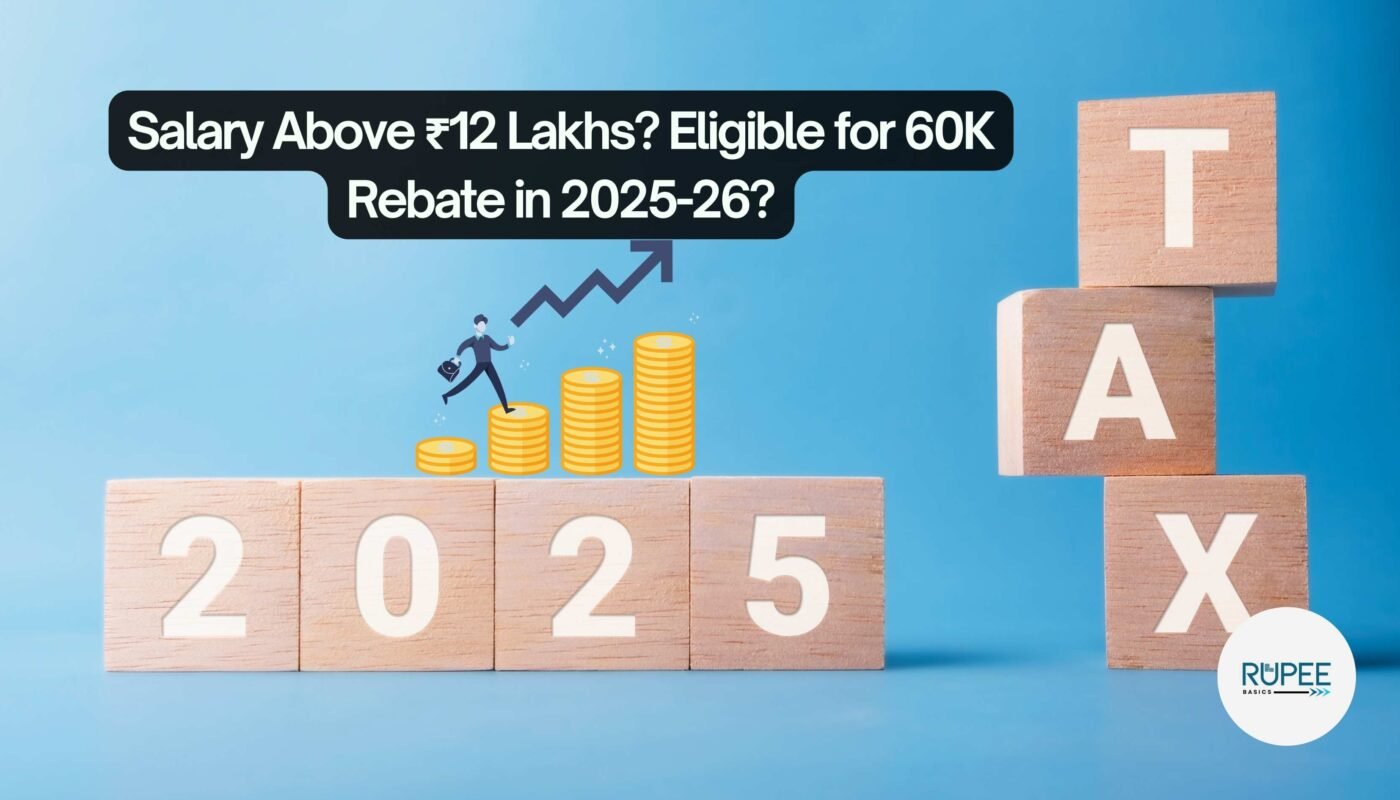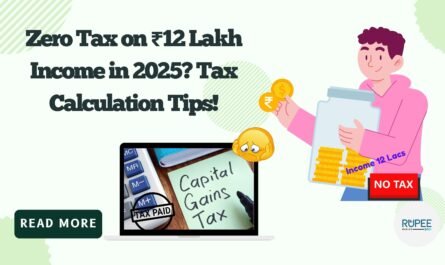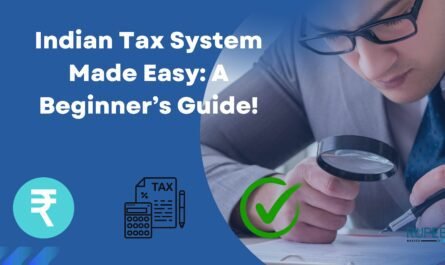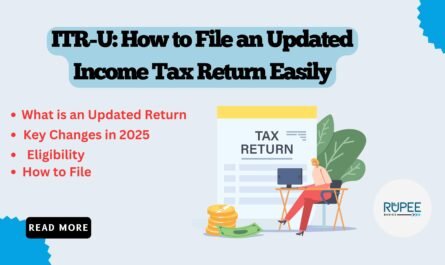Navigating the complexities of income tax can be challenging, especially with recent changes introduced in the Union Budget for the Financial Year (FY) 2025-26. A significant update pertains to the rebate under Section 87A, which offers substantial relief to taxpayers. This blog aims to elucidate the nuances of Section 87A, the revised tax slab rates under the new regime, and guide you in choosing the most suitable tax regime for your financial situation.
Tax season can be confusing, especially with changing rules. One common doubt is: “If my salary crosses ₹12 lakhs (effectively Rs 1275000 with Std Deduction) in FY 2025-26, will I still get the Section 87A rebate?” Let’s break it down in simple terms, covering:
Understanding Section 87A Rebate for FY 2025-26 and Eligibility:
Section 87A of the Income Tax Act provides a rebate to individual taxpayers whose taxable income does not exceed a specified limit. For FY 2025-26, the Union Budget has increased this limit, allowing more taxpayers to benefit from the rebate.
Key Highlights:
- Eligibility: Resident individuals with a taxable income up to ₹12 lakh are eligible for the rebate under the new tax regime.
- Rebate Amount: The maximum rebate available is ₹60,000 or the total tax payable, whichever is lower.
- Standard Deduction: A standard deduction of ₹75,000 is applicable, effectively increasing the tax-free income to ₹12.75 lakh.
Example:
Consider a salaried individual with a gross income of ₹12.75 lakh:
- Gross Income: ₹12,75,000
- Standard Deduction: ₹75,000
- Taxable Income: ₹12,00,000 (₹12,75,000 – ₹75,000)
- Tax Calculation:
- Up to ₹4,00,000: Nil
- ₹4,00,001 to ₹8,00,000: 5% of ₹4,00,000 = ₹20,000
- ₹8,00,001 to ₹12,00,000: 10% of ₹4,00,000 = ₹40,000
- Total Tax Before Rebate: ₹60,000
- Rebate Under Section 87A: ₹60,000 (since the taxable income is within the ₹12 lakh limit)
- Total Tax Payable: ₹60,000 – ₹60,000 = ₹0
In this scenario, the individual’s tax liability is nullified due to the rebate.
Section 87A allows taxpayers to claim a rebate (reduction) on their tax liability if their income is below a certain limit.
Key Points for FY 2025-26 (AY 2026-27)
- Eligibility: Only available under the new tax regime.
- Income Limit: Up to ₹12 lakhs (Full rebate = No tax if income ≤ ₹12L). (You can claim Std deduction of Rs. 75,000, effectively Income up to Rs 12,75,000 will have NO tax)
- If income exceeds ₹12L: Rebate reduces and disappears completely if income crosses ₹12 lakhs.
Example:
- Income = ₹11.9L → Tax = ₹0 (Full rebate).
- Income = ₹12L → Rebate applies.
- Income = ₹12.5L → No rebate under Section 87A.
- Note: The Income Shown above is considered after the standard deduction of Rs 75000 for a salaried employee.

Income Tax Slab Rates Under the New Regime for FY 2025-26
The new tax regime introduces revised slab rates aimed at simplifying the tax structure:
- Up to ₹4,00,000: Nil
- ₹4,00,001 to ₹8,00,000: 5%
- ₹8,00,001 to ₹12,00,000: 10%
- ₹12,00,001 to ₹16,00,000: 15%
- ₹16,00,001 to ₹20,00,000: 20%
- ₹20,00,001 to ₹24,00,000: 25%
- Above ₹24,00,000: 30%
Note: These rates are applicable under the new tax regime, which does not allow certain exemptions and deductions available in the old regime.
Choosing Between the Old and New Tax Regimes
Deciding which tax regime to opt for depends on various factors, including your income level, eligible deductions, and financial goals.
Old Tax Regime:
- Pros:
- Allows multiple exemptions and deductions (e.g., Section 80C, 80D, HRA).
- Beneficial for individuals with significant investments in tax-saving instruments.
- Cons:
- Higher tax rates compared to the new regime.
- Complex due to numerous exemptions and deductions.
New Tax Regime:
- Pros:
- Lower tax rates.
- Simplified tax structure with fewer compliances.
- Cons:
- Limited exemptions and deductions.
- May not be advantageous for those with substantial tax-saving investments.
Considerations:
- Income Level: If your income is up to ₹12.75 lakh (With Std Deduction), the new regime may be more beneficial due to the enhanced rebate and standard deduction.
- Investments: If you have significant investments in tax-saving instruments, the old regime might offer better tax savings.
- Simplicity: For those seeking a straightforward tax filing process, the new regime’s simplified structure could be appealing.
Conclusion
The enhancements in Section 87A and the revised tax slabs under the new regime for FY 2025-26 provide substantial relief to taxpayers, especially those with incomes up to ₹12.75 lakh. While the new regime offers lower tax rates and simplicity, the old regime’s deductions and exemptions may still be advantageous for certain individuals. It’s imperative to assess your financial situation, investment portfolio, and tax-saving goals to make an informed decision on which regime to opt for.
FAQs
1. Will I get the Section 87A rebate if my salary exceeds ₹12 lakh in FY 2025-26?
No, the rebate under Section 87A is available only for taxable incomes up to ₹12 lakh. If your taxable income exceeds this limit, you will not be eligible for the rebate.
Certainly! Here are additional FAQs to provide a more comprehensive understanding of the tax implications for FY 2025-26:
2. How does the standard deduction impact my taxable income under the new tax regime?
The standard deduction of ₹75,000 is subtracted from your gross income to determine your taxable income. For example, if your gross income is ₹13 lakh, after the standard deduction, your taxable income would be ₹12.25 lakh.
3. Are senior citizens eligible for additional benefits under Section 87A?
No, the rebate under Section 87A is uniformly applicable to all resident individuals, including senior citizens, provided their taxable income does not exceed ₹12 lakh under the new tax regime.
4. Can I claim deductions under Section 80C in the new tax regime?
No, the new tax regime does not allow common deductions like those under Section 80C. However, it offers lower tax rates and a higher standard deduction.
5. What happens if my taxable income is slightly above ₹12 lakh?
If your taxable income marginally exceeds ₹12 lakh, you won’t be eligible for the Section 87A rebate, and standard tax rates will apply to your entire taxable income.
6. Is the old tax regime still available for taxpayers in FY 2025-26?
Yes, taxpayers can choose between the old and new tax regimes. The old regime allows various deductions and exemptions but has higher tax rates.
7. How do I decide which tax regime is more beneficial for me?
Evaluate your eligible deductions and exemptions under the old regime. If these significantly reduce your taxable income, the old regime may be beneficial. Otherwise, the new regime’s lower tax rates and higher standard deduction might be advantageous.
8. Are non-resident Indians (NRIs) eligible for the Section 87A rebate?
No, the rebate under Section 87A is available only to resident individuals. NRIs are not eligible for this rebate.
9. Has the basic exemption limit changed in the new tax regime for FY 2025-26?
Yes, the basic exemption limit has been increased from ₹3 lakh to ₹4 lakh in the new tax regime.
10. Can I switch between the old and new tax regimes every year?
Salaried individuals can choose between the old and new tax regimes each financial year. However, individuals with income from business or profession have a one-time option to switch back to the old regime after opting for the new regime.
11. Are there any tax-saving strategies available under the new tax regime?
While the new tax regime offers limited deductions, investing in the National Pension System (NPS) under Section 80CCD(2) for employer contributions is still beneficial.
12. How does the new tax regime affect individuals with income above ₹24 lakh?
For individuals with income above ₹24 lakh, the tax rate is 30% under the new tax regime.
13. Are there any special provisions for very senior citizens under the new tax regime?
No, the new tax regime does not provide additional benefits for very senior citizens (aged 80 and above); the same tax slabs apply to all individuals.
14. How does the new tax regime impact HRA and LTA claims?
Under the new tax regime, exemptions for House Rent Allowance (HRA) and Leave Travel Allowance (LTA) are not available.
15. Is the Section 87A rebate applicable before or after adding the Health and Education Cess?
The Section 87A rebate is applied to the income tax before adding the 4% Health and Education Cess.
16. Can I claim both the standard deduction and Section 87A rebate under the new tax regime?
Yes, under the new tax regime, you can claim both the standard deduction of ₹75,000 and the Section 87A rebate, provided you meet the eligibility criteria.
17. How does the new tax regime affect deductions under Section 80D for health insurance premiums?
Deductions under Section 80D for health insurance premiums are not available in the new tax regime.
18. Are deductions for home loan interest under Section 24(b) available in the new tax regime?
No, the deduction of up to ₹2 lakh for home loan interest under Section 24(b) is not available in the new tax regime.
19. How does the new tax regime impact deductions for education loans under Section 80E?
Deductions for interest on education loans under Section 80E are not available in the new tax regime.
20. Can I claim deductions for charitable donations under Section 80G in the new tax regime?
No, deductions for charitable donations under Section 80G are not available in the new tax regime.
21. Are agricultural incomes taxable under the new tax regime?
Agricultural income remains exempt from tax under both the old and new tax regimes.
22. How does the new tax regime affect capital gains taxation?
The new tax regime does not change the taxation rules for capital gains; they continue to be taxed as per existing provisions.
23. Are family pensioners eligible for the standard deduction under the new tax regime?
Yes, family pensioners can claim a standard deduction of ₹75,000 or one-third of the pension, whichever is less, under the new tax regime.
24. How does the new tax regime impact self-employed individuals?
Self-employed individuals can opt for the new tax regime but will forego deductions like those under Section 80C, 80D, and 80E.
25. Are there any rebates available for senior citizens under the new tax regime?
The Section 87A rebate is available to all resident individuals, including senior citizens, with taxable income up to ₹12 lakh under the new tax regime.
26. How does the new tax regime affect deductions for disability under Section 80U?
Deductions under Section 80U for disability are not available in the new tax regime.
27. Can I claim the standard deduction if I have no salary income but have pension income?
Yes, pension income is treated as salary income, so standard deduction is allowed as usual from the pension income.
“Success is about making the right decisions consistently over time.”




